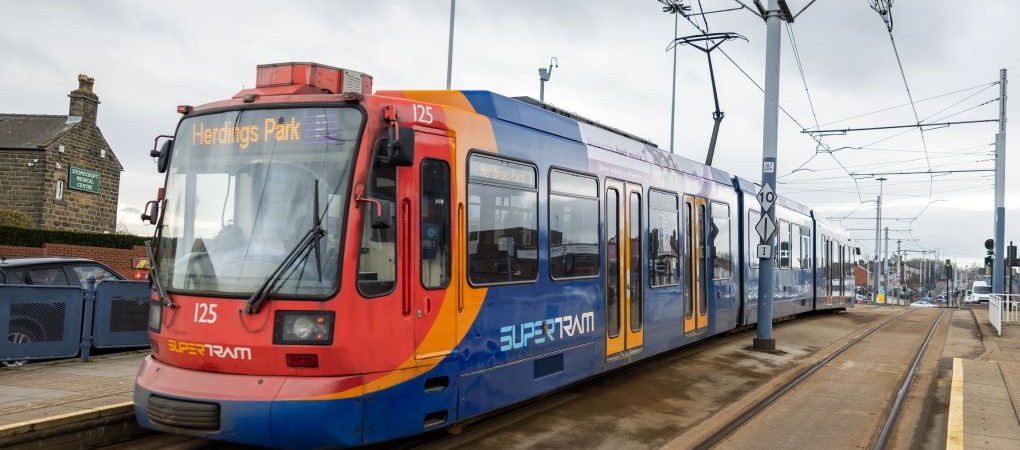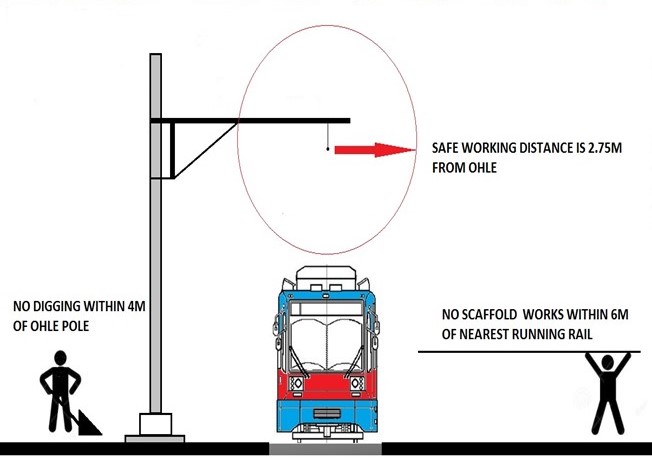
Working on or near the Supertram network
Staying safe when working close to Supertram tracks and equipment is easy as long as a few sensible precautions are followed.
If you need to work on or around the Supertram system, please take note of the guidelines below before starting work:
- trams cannot be diverted around a work site
- trams are powered from 750 volts DC overhead power lines that are live at all times
- cables, services and ancillary equipment may be buried or hidden
- before any work starts, you must agree a safe method of work with us and obtain authorisation to carry out the works
- if you are a property owner or business owner adjacent to the Supertram system and are having works carried out to your building, it is your responsibility to make them aware of the hazards and the need to obtain authorisation.

Authorisation
Authorisation is required for any of the following activities:
- work where part of the site encroaches within 1.5m of the nearest running rail
- work where machinery is to be used that come/could come within 1.5m of the nearest running rail or 2.75m of the overhead line equipment (e.g. forklift, cherry picker, genie boom, cranes)
- work where the tooling, materials, suspended loads, ladders or persons associated with the works that come within 1.5m of the nearest running rail or 2.75m of the overhead line equipment (OHLE)
- any excavation that comes within 4m of any overhead support pole
- any piling, boring, slinging or excavation that comes within 4m of any part of Supertram equipment or boring under the Supertram track/equipment
- any work that could force pedestrians and or motorists to be diverted into direct conflict with Supertram
- any scaffolding works within 6m of the nearest running rail or 2.75m from the OHLE equipment
- abnormal load vehicles that cross or travel along the Supertram system
Third Party Work Request Form
To get authorisation, you must fill out a Supertram Third Party Work Request Form. We will need to know the:
- nature of the works
- exact location
- date and time of works
Method Statements and Risk Assessments may also be required.
Work Request forms must be submitted at least three weeks before the start date so that site meetings and a safe system of work can be arranged/agreed at the earliest opportunity.
If your works encroach onto any part of the highway or footpaths, then approval/permits will be required from the Highways Authority separately.
We may need to contact or meet with you to find out more about the works. If precautions are necessary, we will tell you in writing and agree them with you.
Wherever possible, we will always try to find a way that you can carry out works during the normal operational hours. However, some work may have to be undertaken at night with the overhead power switched off and this may take longer to arrange than the three weeks’ minimum notice.
There is a charge for this service. You will be told how much during the application process.
Isolation of the overhead lines will only be confirmed by issuing a Supertram Permit to Work to the agreed work party involved (by prior arrangement).
Emergency work
If urgent works must be carried out to protect people, property or the environment you must still contact us to agree the scope of works and set out a safe system of work before you start.
We'll come to site if necessary, but there may be a charge to cover our costs.
Our control room officers can be contacted in an emergency 24 hours a day, 365 days a year by calling 0114 279 8126.
Emergencies while working
If you encounter a problem that obstructs the track or overhead or Supertram equipment is damaged please contact the Supertram control room immediately on the number above.
Our Network Coordinators will need to know:
- who you are and your exact location
- the nature of the emergency
- if the track is obstructed
- if anything is touching the overhead lines
- if emergency services are required
- whether the Supertram service needs to be suspended immediately
By answering these questions quickly and clearly, we will be able to advise you and take the necessary steps to make the situation as safe as possible.
Should a tram need to be stopped before a call can be made, this can be done by standing clear of the tram tracks/road and holding both arms above your head waving directly at the tram driver.
Once stopped the driver can also make an emergency call direct to the control room.
